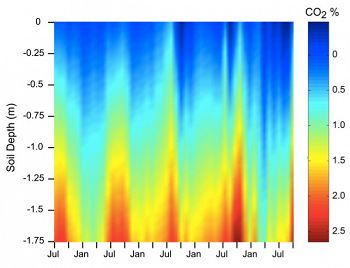Richter & Billings, 2015
'One Physical System': Tansley's ecosystem as Earth's critical zone
Richter, D. deB., and S.A. Billings (2015)
New Phytologist 206 (3): 900-912
-
Calhoun, INVESTIGATOR
-
Calhoun, INVESTIGATOR
Abstract
Average concentrations of CO2 in soil atmospheres of the Calhoun Experimental Forest under an approximately 40-yr-old loblolly pine forest. Periodically measured CO2 data plotted with Matlab.
Integrative concepts of the biosphere, ecosystem, biogeocenosis and, recently, Earth's critical zone embrace scientific disciplines that link matter, energy and organisms in a systems-level understanding of our remarkable planet. Here, we assert the congruence of Tansley's (1935) venerable ecosystem concept of ‘one physical system’ with Earth science's critical zone. Ecosystems and critical zones are congruent across spatial–temporal scales from vegetation-clad weathering profiles and hillslopes, small catchments, landscapes, river basins, continents, to Earth's whole terrestrial surface. What may be less obvious is congruence in the vertical dimension. We use ecosystem metabolism to argue that full accounting of photosynthetically fixed carbon includes respiratory CO2 and carbonic acid that propagate to the base of the critical zone itself. Although a small fraction of respiration, the downward diffusion of CO2 helps determine rates of soil formation and, ultimately, ecosystem evolution and resilience. Because life in the upper portions of terrestrial ecosystems significantly affects biogeochemistry throughout weathering profiles, the lower boundaries of most terrestrial ecosystems have been demarcated at depths too shallow to permit a complete understanding of ecosystem structure and function. Opportunities abound to explore connections between upper and lower components of critical-zone ecosystems, between soils and streams in watersheds, and between plant-derived CO2 and deep microbial communities and mineral weathering.
Citation
Richter, D. deB., and S.A. Billings (2015): 'One Physical System': Tansley's ecosystem as Earth's critical zone. New Phytologist 206 (3): 900-912. DOI: 10.1111/nph.13338
 This Paper/Book acknowledges NSF CZO grant support.
This Paper/Book acknowledges NSF CZO grant support.
Explore Further



